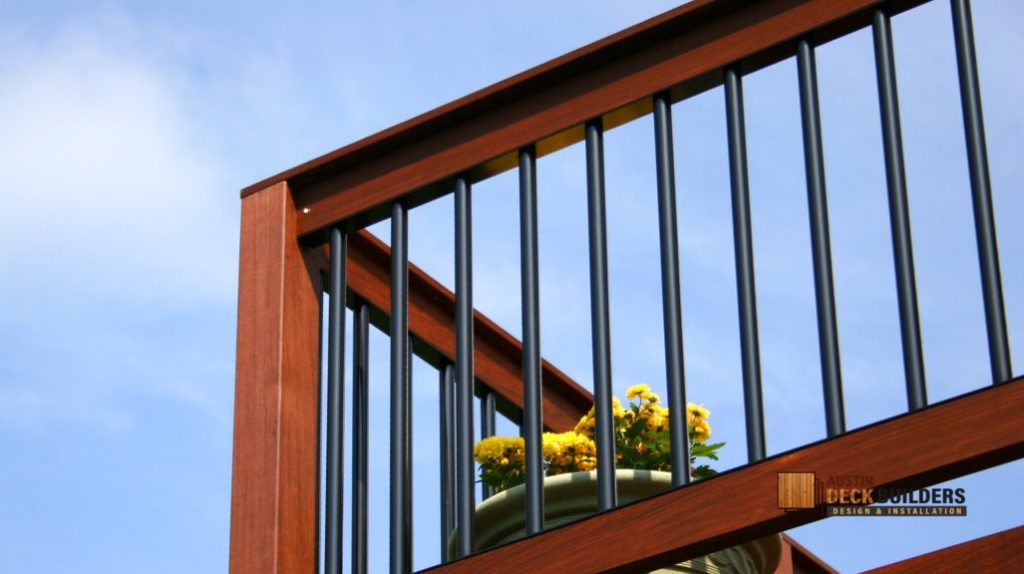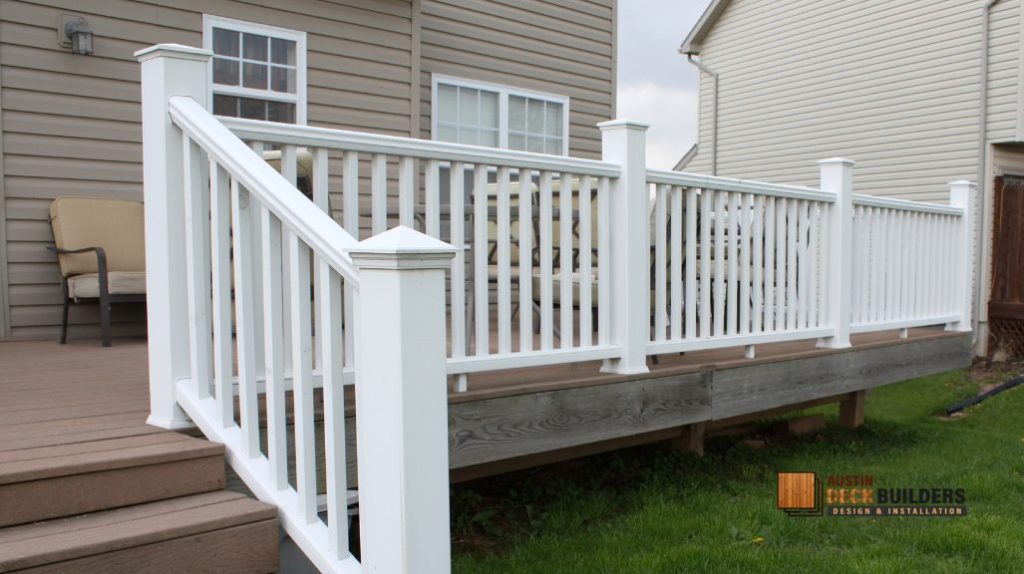Deck railings are essential to your outdoor living space’s safety, functionality, and aesthetics. Over time, they can loosen or sustain damage due to regular wear, exposure to weather elements, or improper installation. Deck restoration becomes crucial when weaknesses between railing posts and the deck framing lead to loose or wobbly railings. It is important to use appropriate metal hardware to connect these elements. Additionally, maintaining deck hardware is vital as it is vulnerable to moisture, UV rays, and temperature changes, which can lead to rust and deterioration. Regular inspections and using durable materials for replacements ensure the longevity and safety of deck railings. Whether you’re addressing loose railings, damaged hardware, or broken railing posts, this guide will walk you through the steps to fix your deck railings safely and effectively with the right deck repair techniques.
At Austin Deck Builders – Design & Installation, we understand the importance of maintaining a sturdy and secure deck. With this comprehensive guide, you’ll learn how to identify issues, gather the right tools, and complete the necessary repairs for a safe and beautiful outdoor space.
Why Loose Deck Railings Become Damaged

Deck railings endure significant stress from daily use, environmental conditions, and time. Common causes of damage include:
- Normal Wear and Tear: Over time, fasteners like screws and bolts may loosen.
- Weather Damage: Exposure to UV rays, moisture, and strong winds can cause wood to warp, weaken, or rot.
- Rusted or Broken Hardware: Worn or rusted hardware compromises the railing’s stability.
- Improper Installation: Poorly aligned posts or inadequate fastening can result in a wobbly railing.
- Deck Railing Posts: Inspecting deck railing posts for stability is crucial. Loose or damaged posts can compromise the entire railing system. Reinforce these posts with additional hardware and blocking techniques to ensure safety and longevity.
Identifying the root cause is the first step to ensuring a lasting repair.
Tools and Materials You’ll Need
Before starting your repair, gather the following tools and materials:
Tools:
- Hammer
- Nail puller or pry bar
- Screwdriver
- Circular saw
- Measuring tape
- Drill
- Sandpaper
Materials:
- Pressure-treated wood for replacement pieces
- Deck screws or carriage bolts
- Metal brackets for added reinforcement
- Weatherproof paint or deck stain
- Deck hardware for ensuring stability and safety of railings
Having these items on hand ensures you can address common issues effectively. Choosing the right materials for your deck railings can significantly affect their durability. For more information, check out this blog: Cedar vs. Composite Decking: Choosing the Best Material for Your Outdoor Space.
Step-by-Step Guide to Fixing Deck Railings

1. Inspect the Damage
Conduct a thorough inspection of your deck railing to identify:
- Loose screws or bolts
- Cracks in the wood or railing posts
- Areas with rusted hardware
- Signs of wood rot on surrounding wood or posts
- Stability of deck railing posts
- Damage to deck hardware
Use this inspection to determine whether parts need reinforcement, tightening, or full replacement.
2. Tighten Loose Railings
For minor looseness:
- Check all fasteners, including screws, bolts, and nails, ensuring they are securely tightened.
- Replace damaged hardware, such as rusted screws or bolts, with new ones.
- Avoid overtightening, which can weaken the wood.
- Inspect the deck components for potential problems such as rusted hardware, cracks, or wood rot. If you find any issues, address them promptly to fix a loose outdoor railing and ensure safety and stability.
3. Replace Damaged Components
If parts of your railing are damaged:
- Railing Posts: Detach the loose railing posts using a pry bar. Cut a replacement post from pressure-treated wood, ensuring it matches the original dimensions. Secure the new post with deck screws and reinforce it with metal brackets. Inspect and maintain your deck railing posts regularly, as loose or damaged posts can compromise the stability of the railing system. Use appropriate fasteners to prevent rust and corrosion, and consider additional hardware and blocking techniques for reinforcement to ensure safety and longevity.
- Broken Treads or Boards: Replace damaged boards with new ones, using the correct length and width. Sand the edges to remove any rough areas before securing.
- Hardware Replacement: Remove and replace any rusted hardware to restore stability.
4. Reinforce Weak Areas
For added stability:
- Install metal brackets at connection points between the railings and the rim joists.
- Use carriage bolts to secure railing posts firmly to the deck structure.
- Add additional fasteners if the original configuration lacks adequate support.
- Use appropriate metal hardware to ensure the deck framing is robust and properly connected to the railing posts. Regularly inspect the deck framing to prevent damage from environmental factors, which can lead to loose or wobbly railings.
Check out our blog post on How to Repair Deck Joists: A Step-by-Step Guide
5. Sand and Seal the Wood
Smooth out any rough edges or splinters using sandpaper. Apply a deck stain or weatherproof paint to protect the wood from moisture, UV damage, and rot. This step enhances durability and improves the appearance of your railings.
Preventative Maintenance Tips

To ensure your deck railings remain safe and sturdy, follow these maintenance practices:
- Regular Inspections:
- Check for loose screws, bolts, or signs of damage at least twice a year.
- Inspect deck hardware for signs of rust, deterioration, or other damage caused by moisture, UV rays, and temperature changes.
- Inspect deck railing systems to ensure they are secure and functional, replacing any damaged or outdated components to maintain safety and longevity.
- Clean Regularly: Remove debris and clean the railings with a mild detergent to prevent rot and corrosion.
- Apply Weatherproof Finishes: Reseal your railings with UV-resistant stain or paint every 1–2 years.
- Protect Against Heavy Loads: Avoid placing heavy objects or exerting undue pressure on railings to prevent future damage.
FAQs About Fixing Deck Railings
When to Call Professional Deck Builders
While minor repairs are manageable as DIY projects, more complex issues such as widespread rot, structural instability, or large-scale replacements require professional expertise. Regular inspections of deck framing for signs of damage are crucial to maintaining secure railings. Additionally, using durable deck hardware for reinforcement can prevent deterioration caused by environmental factors. A trusted contractor ensures your deck railings are repaired to the highest safety standards.
Is your deck railing wobbly or damaged? Trust the Austin Deck Builders – Design & Installation experts to restore your deck’s safety and beauty. Contact us today for reliable deck repair services in Austin and bring your outdoor space back to life.

